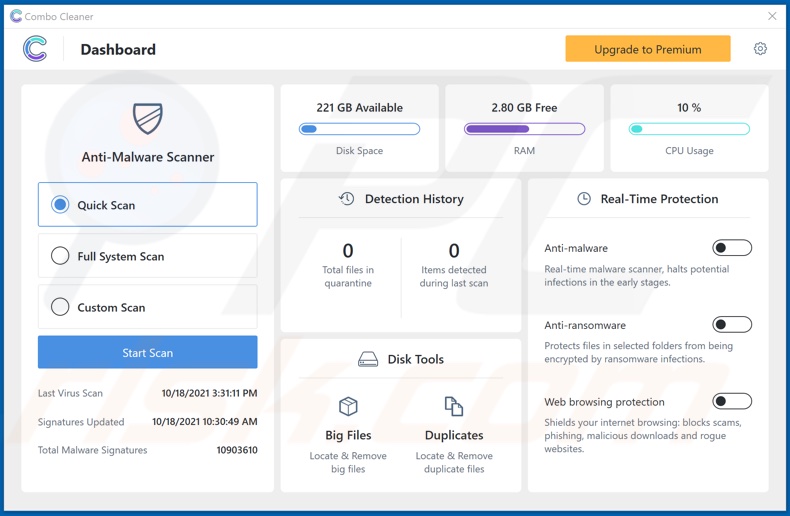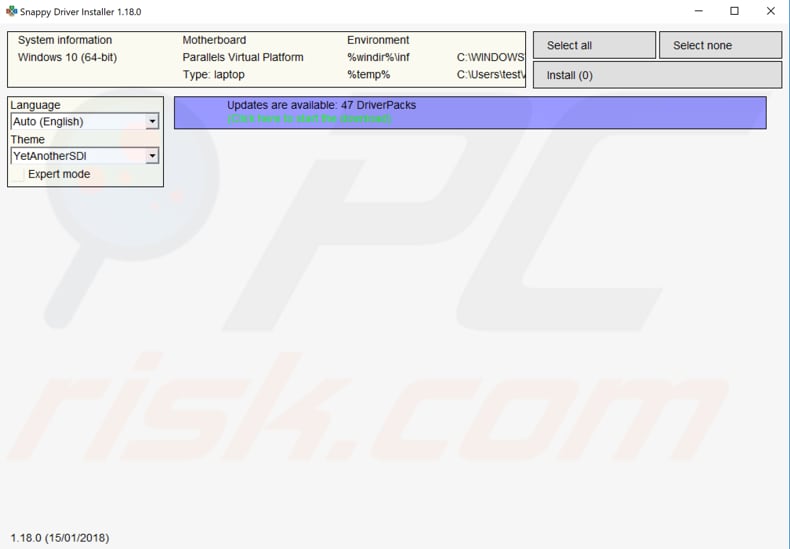What Is Taskeng.exe?
![]() Written by Rimvydas Iliavicius on
Written by Rimvydas Iliavicius on
What Is Taskeng.exe, Why Is It Randomly Showing up, and How to Fix Issues Related to Taskeng.exe Process on Windows 10
Windows Task Scheduler is a Windows component that allows scheduling the launch of programs or scripts at predefined times or after specified intervals. In this article, we will show several solutions in case you are having any issues with the taskeng.exe process.

"Taskeng" stands for Task Scheduler Engine, and it is a part of Windows. This file is usually located in C:\Windows\System32 folder, and you can find this file on Windows operating system versions, including Windows 10, 8, 7, and XP.
Taskeng.exe is the Task Scheduler service, and it is responsible for keeping track of tasks set to run at a time predetermined by the user and invoking these tasks when necessary. It does this by monitoring your selected criteria and then executing predefined tasks when the criteria are met.
However, the Taskeng.exe process sometimes can be a virus as well. Some viruses or Trojans use the same file name to remain undetected.
The issues include the appearing blank area on your screen, the Taskeng.exe process consumes a considerable amount of your system resources or causes periodical freezing of your Windows operating system.
Read the article below to find out how you can solve the problems related to the Task Scheduler Engine (taskeng.exe) process. The steps found below include scanning your system for viruses, checking Windows system files, repairing corrupted ones, cleaning your hard drive, etc.
Table of Contents:
- Introduction
- Run Full System Scan
- Run SFC Scan
- Clean Your Drive Using Disk Cleanup Tool
- Uninstall Unnecessary Software From Your Windows
- Check for Windows Updates
- Repair Your Operating System Using DISM
- Update Your Drivers
- Restore Your System Using Restore Points
- Video Showing How to Fix Problems Related to Taskeng.exe
Run Full System Scan
One of the reasons you may have problems with the taskeng.exe process is if your computer is infected with malware. There is a possibility that the taskeng.exe process is a component of the malicious software.
Perform a full system scan and see if it detects any malware on your computer. You can use Windows Defender (a built-in antivirus program), which protects your computer against viruses, spyware, other malicious software. Or you can use any other third-party antivirus.
To run a full system scan using Windows Defender, type "defender" in Search and click on the "Windows Defender settings" result.

Click "Open Windows Defender Security Center" on the right pane.

In the Virus & threat protection window, click "Advanced scan".

Select "Full scan" and click "Scan now". This will start scanning your system for malware. If there are any viruses found, delete them and see if the problem is fixed.

We also recommend you try out a third-party anti-malware software called Combo Cleaner. Combo Cleaner is an anti-malware software for Microsoft Windows and macOS that finds and removes malware. You can download Combo Cleaner by clicking this link.

Run SFC Scan
System File Checker (SFC) is a utility in Windows that allows users to scan for corruptions in Windows system files and restore corrupted files. The "sfc scannow" option is one of the several specific switches available in the SFC command, the Command Prompt command used to run System File Checker.
To run it you need to open Command Prompt first. To open it, type "command prompt" in Search and then right-click on the "Command Prompt", select "Run as administrator" from the dropdown menu to run Command Prompt with administrator privileges. You must run an elevated Command Prompt to perform an SFC scan.

You will be asked if you want to allow this app to make changes to your device. Select "Yes".

In opened Command Prompt window type "sfc /scannow" and press Enter on your keyboard to execute this command. System File Checker will start, and it should take some time to complete the scan. It should take about 15 minutes.
Wait for the scanning process to complete and restart your computer to see if you still have issues with the taskeng.exe service.

Clean Your Drive Using Disk Cleanup Tool
The simplest and quickest way to delete temporary files, folders, and other junk from your Windows is to use Disk Cleanup. Disk Cleanup is used to reduce the number of unnecessary files on your drives, which can help your PC run faster.
It can delete temporary files and system files, empty the Recycle Bin, and remove various other items that you might no longer need. These junk files may affect your computer's processing speed, causing apps to respond slowly and can even prevent them from launching.
We are going to use the Command Prompt to run Disk Cleanup. To open it, type "command prompt" in Search and then right-click on the "Command Prompt", select "Run as administrator" from the dropdown menu to run Command Prompt with administrator privileges.

In the Command Prompt window, type "cleanmgr" and press Enter to execute this command.

Disk Cleanup Tool window will show up. Choose the files you want to delete (this tool also shows how much space you can free up by deleting certain files and folders) and click "Clean up system files".

Uninstall Unnecessary Software From Your Windows
To uninstall the unnecessary software from your computer, type "run" in Search and click on the "Run" result and it will open the Run dialog box for you.
Type "appwiz.cpl" and press Enter. This will launch "Programs and Features" window.

In opened Programs and Features window, locate the program and uninstall it by right-clicking on it and choosing "Uninstall" from the dropdown menu.

If there are any programs you cannot remove from your computer using the "Programs and Features" in Windows, we recommend you use a third-party software called CCleaner. CCleaner is a utility for computers running Microsoft Windows that cleans 'junk' and accumulated issues: temporary files, broken shortcuts, and other problems.
It protects your privacy, cleans your browsing history and temporary internet files, allowing you to be a more confident Internet user and less susceptible to identity theft. CCleaner can clean redundant files from various programs saving hard disk space, remove unneeded entries in Windows Registry, help you uninstall software, and select which programs start with Windows. You can download CCleaner from here.
Open CCleaner when downloaded and click "Tools" on the left pane. Select the "Uninstall" section to start uninstalling programs/remove entries you no longer need. Simply click the program name and then click "Uninstall" in the top-right corner. If you want to remove the entry from the program list, click "Delete".
Restart your computer when finished for the changes to take effect. You should no longer see those programs on the Add/Remove Programs list.

Check For Windows Updates
Another thing you might want to try is to update your current version of Windows. Checking for updates for the whole Windows operating system might help. To check for Windows Updates, type "check for updates" in Search and click the "Check for updates" result.

You should be automatically directed to the Windows Update section. Click "Check for updates", and Windows will start checking for updates. If there are updates available, install them and check for updates again to ensure that you have the latest updates on your operating system.
After the updates are installed, see if you still have issues with the taskeng.exe.

Repair Your Operating System Using DISM
DISM stands for Deployment Image Servicing and Management, and it can be used to repair and prepare Windows images, including the Windows Recovery Environment, Windows Setup, and Windows PE. To run the DISM scan, you need to open Command Prompt as administrator again.
Type "command prompt" in Search and then right-click on the "Command Prompt", select "Run as administrator" from the dropdown menu to run Command Prompt with administrator privileges.
Type in this command: "DISM /Online /Cleanup-Image /RestoreHealth". Press Enter on your keyboard to execute it. See if this solves the issues you are having with taskeng.exe.

Update Your Drivers
Issues with taskeng.exe can be related to corrupt or outdated device drivers. However, finding the particular driver which is causing problems manually could be pretty tricky. This could be very time-consuming as well. Not to mention that there is a possibility of installing the wrong drivers while trying to update the current ones.
The good news is that there is third-party software such as Snappy Driver Installer. You will need a computer with a working internet connection to download it.
Snappy Driver Installer (SDI) is a powerful free driver updater tool for Windows that can store its entire collection of drivers offline. You can download Snappy Driver Installer from here.

Restore Your System Using Restore Points
The System Restore tool creates restore points. A restore point is a collection of important system files stored by System Restore on a given date and time. System Restore reverts everything to a saved restore point, but first, you must have one recorded. If a restore point does not exist on your computer, System Restore has nothing to revert to.
To use this tool, you must have created restore points. With a created restore point, this feature will bring your system back to the previous working state, without affecting your files and data.
This solution is a last resort, but if you have any system restore points created before you started experiencing issues with the taskeng.exe, you might be able to fix the problem by performing a System Restore. To restore your system, launch Run. To start it, press the Windows Key + R and type "rstrui.exe". In the Run dialog box, press Enter or click "OK".

In the System Restore window, click "Next".

If there are restore points created, you will see a list of them. Mark the "Show more restore points" checkbox, and it should display more restore points. Select the restore point that suits you best (depending on the time created etc.) and click "Next".
Do not select a Restore Point when the issues with the taskeng.exe process were already present - you certainly do not want to revert to that state.

Confirm your restore point. Your computer will be restored to the state before the event detailed in the "Description" field. If you are happy with your choice, click "Finish" and begin the system restore process.

We hope that this article helped you to understand what is this taskeng.exe process and what it does. If you were having issues with this process, then hopefully, this guide was helpful, and you could resolve them.
If you have other suggestions about how to solve problems related to taskeng.exe, don't hesitate to leave a comment in our comment section at the bottom.

▼ Show Discussion